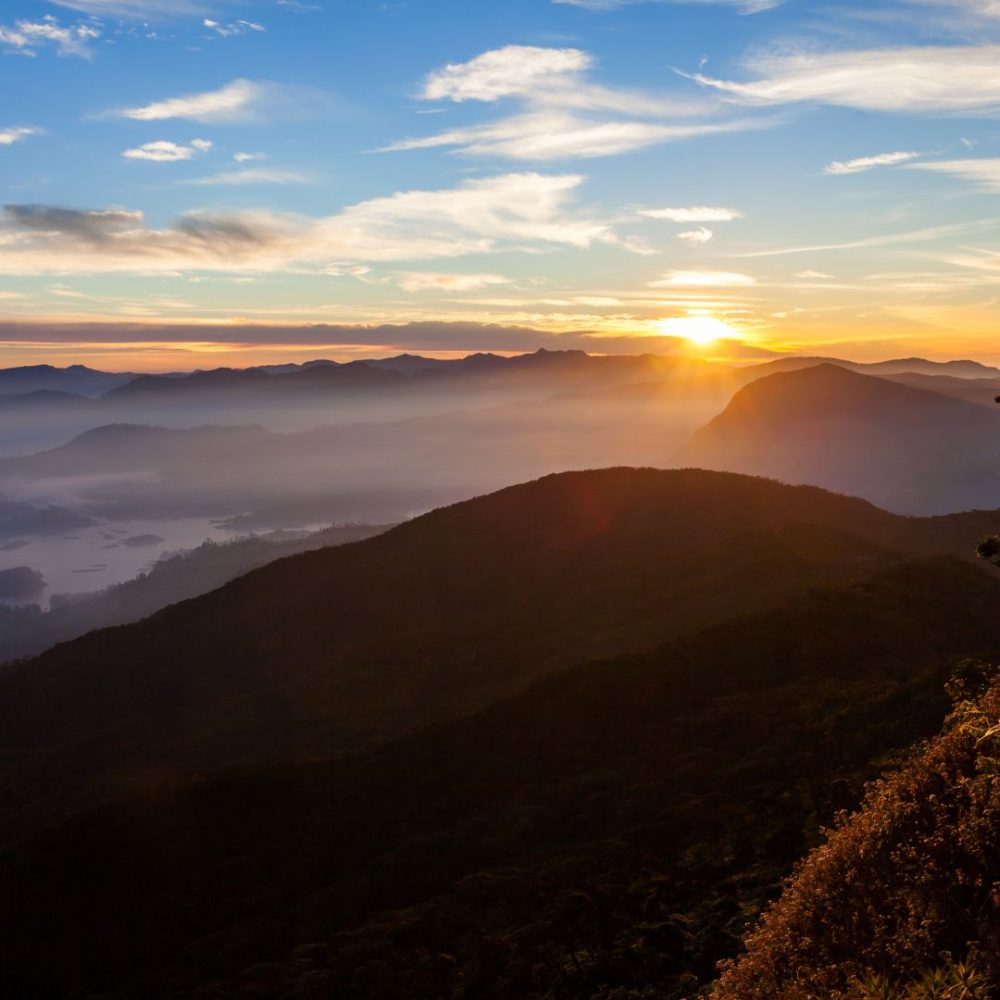One of the most important places to see in Sri Lanka is Adam’s Peak, a massive conical mountain rising to a height of 2,243 meters in the country’s central highlands that is equally revered by all major religions for the sacred footprint it bears. In addition to being a revered travel destination, Adam’s Peak is highly sought-after by travelers due to its captivating beauty and unparalled hiking experience. The peak, also referred to as Samanala Kanda (butterfly mountain) and Sri Pada (holy footstep), is the seventh highest peak in Sri Lanka.
“Adams Mountain”
What Are Adam’s Peak’s Tourist Attractions?
Most religious groups consider Adam’s Peak to be a sacred site. A large rock with a massive footprint on top of it is treasured. This footprint is thought to represent the footprints of Lord Buddha in the Buddhist tradition, Sri Rama in Hindu mythology, and Adam in Christian and Islamic beliefs. With hills covered in dense vegetation all the way up, the peak is quite attractive and makes for the ideal trekking experience. In addition, the peak has many waterfalls and serves as the headwaters for four of the nation’s most well-known rivers, the Kalu, Mahaweli, Kelani, and Walawe, as well as numerous other tributaries. Adam’s Peak is home to a diverse array of rare birds, reptiles, and mammals. Its rich endemic flora contributes to its rich biodiversity.


The Historical Context of Adam’s Peak
If you ask the locals about the history of this sacred mountain, Adam’s Peak—whose history dates back to the pre-Christian era—you will hear different answers that make it special to all religions. Buddhists think that it was their lord’s dwelling. Hindus maintain, however, that their folktale places Ravana, King of Asura hiding in Adam’s Peak after he kidnaped Seetha, the queen of Lord Rama from India. Muslims believe that Adam descended directly to Adam’s Peak following the incident involving the forbidden fruit from Heaven. The first offerings made by sun worshippers are said to have been made here in 140 BC with King Dutugemunu, who is said to have healed him on his deathbed as a result of the incident in which he gave staples to monks at Sri Pada. The chronicle of Sri Lanka’s ancient history suggests that Queen Varija, the daughter-in-law of King Kashyapa, is connected to the story of Sri Pada.
The Best Time To Visit Adam’s Peak Based On The Weather & Climate?
In other words, between January and May, when there is less chance of rain and pleasant daylight throughout the day, is the ideal time of the year to visit Adam’s Peak. The safe summer season runs from December through April in the southernmost reaches of the central highlands, where Adam’s Peak is located. There will be clear skies and a pleasant average air temperature of 29 degrees Celsius during this period. The busiest time is in April during the school breaks and Sri Lankan New Year holidays. The pilgrimage season here begins on Duruthu poya day in December or January and lasts until Vesak poya day in May. It is therefore advised that you travel during the early months if you want to climb in peace and comfort. Many climb the mountain at night in order to witness the sunrise from the summit.
Things You Like to Do In Adam’s Peak
There is much more to do at Adam’s Peak than just make the pilgrimage to this 2,243-meter-tall mountain. En route up the mountain, you will be treated to breathtaking views of lush foliage, rustic-looking surroundings, and picturesque valleys. This one might offer you the most enjoyable trekking and hiking experience up the 5,500 steps that make up the incline slopes. To complete the 4 hours of ascent and 2 hours of descent, you only need a good pair of shoes or boots and a reasonable level of fitness. Technical hiking equipment is not necessary. You will have the rare chance to see the full sunrise if you climb in the middle of the night and reach the summit before seven in the morning, when clouds are moving over you. The summit area is set aside for the pilgrimage experience of seeing the footprint and seeing monks and Buddhist monasteries.
The Nightlife & Restaurants Here
Almost all the way up to the peak, during pilgrimage season, there would be a plethora of tea shops and food stalls setting up at regular intervals where you could sit and enjoy some deep-fried local snacks, chickpeas, and Rotis along with coffees and teas made from pure tea powders straight from the plantations, in any case, if you have to maintain a specific diet, it would be preferable to carry your own food. This area would have a busier and more interesting nightlife because most people prefer to climb the peak at night. The entire ascent would be illuminated by lamps and tube lights, whereas during the off-season there might be few food stalls and the path might be dark. Everywhere from here on up, there are brand-new rooms to satisfy the call of nature.
How Could I Get To Adam’s Peak?
There are two different mountain bases from which you can begin your ascent to Adam’s Peak; the more popular one is in Dalhousie, a small village also referred to as Nalathanniya, you’ll also find a variety of eateries and lodging options with excellent cuisine, the less popular one is in Ratnapura, the mountain’s opposite base, and requires longer hours of ascent. The closest city, Hatton or Maskeliya, must be reached before starting from Dalhousie. It is reachable by train or bus from Ella, Kandy or Colombo.